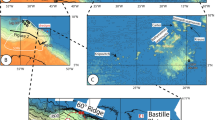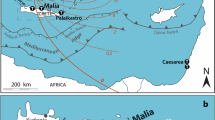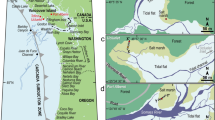Abstract
THE Walvis Ridge is one of the most conspicuous features of the South Atlantic. It extends from near Tristan da Cunha on the Mid-Atlantic Ridge to the African continental margin and has three main segments. The western segment is oriented SW–NE, the central one N–S and the eastern one SSW–NNE. The Walvis Ridge may have kept pace with the opening of the South Atlantic which started in the Early Cretaceous1–6, either by transform fault mechanisms7,8 or by a mantle hot spot and plume9–12. The eastern segment is thought to have been built throughout the Middle Cretaceous, that is, between 120 m.y. ago and 80 m.y. ago13–15. We report information obtained from an investigation of the age and depositional conditions of sedimentary rock recovered during the Walda cruise of the RV Jean Charcot (April–August 1971).
This is a preview of subscription content, access via your institution
Access options
Subscribe to this journal
Receive 51 print issues and online access
$199.00 per year
only $3.90 per issue
Buy this article
- Purchase on Springer Link
- Instant access to full article PDF
Prices may be subject to local taxes which are calculated during checkout
Similar content being viewed by others
References
Creer, K. M., Miller, J. A., and Smith, A. G., Nature, 207, (1965).
Amaral, G., Gordani, U. G., Kawashita, K., and Reynolds, J. H., Geochim. cosmochim. Acta, 30, (1966).
McDougall, I., and Ruegg, N. R., Geochim. cosmochim. Acta 30, (1966).
Saito, T., Ewing, M., and Burckle, L. H., Science, 151, (1966).
Siedner, G., and Miller, J. A., Earth planet. Sci. Lett., 4, (1968).
Maxwell, A. E., Von Herzen, R. P., Hsü, K. H., Andrews, J. E., Saito, T., Percival, S. E., Milow, jun, E. D., and Boyee, R. E., Science, 168, (1970).
Le Pichon, X., and Hayes, D. E., J. geophys. Res., 76, (1971).
Francheteau, J., and Le Pichon, X., Bull. Am. Ass. Petrol. Geo., 56, (1972).
Wilson, J. T., Nature, 207, (1965).
Dietz, R. S., and Holden, J. C., J. geophys. Res., 75, (1970).
Morgan, W. J., Nature, 230, (1971).
Morgan, W. J., Mem. geol. Soc. Am., 132, (1972).
Ladd, J. W., Dickson, G. O., and Pitman, W. C., in The age of the South Atlantic (Nairn and Stehli, New York, 1973).
Sclater, J. G., and McKenzie, D. P., Bull. geol. Soc. Am., 84, (1973).
Goslin, J., Mascle, J., Sibuet, J. C., and Hoskins, H., Bull. geol. Soc. Am. (in the press).
Freinex, S., in Sedimentary basins of the African coasts (Association of African Geological Surveys, 1966).
Noël, D., Coccolithes crétacés, Centre National de la Recherhe Scientifique, Paris (1970).
Brognon, G., and Verrier, G., in Sedimentary basins of the African coasts, (Association of African Geological Surveys, 1966).
Fox, P. J., Heezen, B. C., and Johnson, G. L., Science, 170, (1970).
Sclater, J. G., and Francheteau, J., Geophys. J. R. astr. Soc., 20, (1970).
Author information
Authors and Affiliations
Rights and permissions
About this article
Cite this article
PASTOURET, L., GOSLIN, J. Middle Cretaceous sediments from the eastern part of Walvis Ridge. Nature 248, 495–496 (1974). https://doi.org/10.1038/248495a0
Received:
Issue Date:
DOI: https://doi.org/10.1038/248495a0
Comments
By submitting a comment you agree to abide by our Terms and Community Guidelines. If you find something abusive or that does not comply with our terms or guidelines please flag it as inappropriate.



